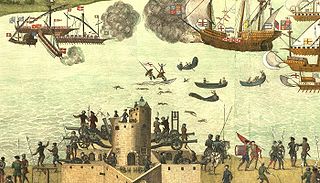Henry Grace à Dieu
|
The Henry Grâce à Dieu in the Anthony Roll (1546)
|
||||||||||||||
|
||||||||||||||
|
||||||||||||||
|
||||||||||||||
|
||||||||||||||
The Henry Grâce à Dieu (also called Great Harry ) was an English warship of the 16th century.
history
The Carrack Henry Grace à Dieu was on the orders of King Henry VIII. Built. The ship was supposed to intervene in a possible war against France . The launch at Woolwich Dockyards in 1514 was a major event. The Henry Grâce à Dieu was at that time the largest ship in the European world and by far the most heavily armed. Although war was expected, the ship began its service in peacetime.
In response to the Henry Grâce à Dieu, the French built the four-masted carrack Grande Françoise , which was only launched in 1535.
From 1536 to 1540 the Henry Grace à Dieu was rebuilt and the armament was somewhat lightened. The ship remained virtually inactive until 1545 when the French attacked Portsmouth harbor . When Edward VI. ascended the throne, the ship, which the soldiers in the meantime only called "Great Harry", was renamed in the name of the monarch. On August 23, 1553, a fire in the shipyard destroyed the ship. The unsuccessful "Reichs-Karacke", as Henry VIII called it, was not restored.
The ship
sail

The Henry Grâce à Dieu had four masts, which for the first time were made up of pieces instead of one piece. Since it was rebuilt several times, the type of sail apparently changed over time: Originally the first two masts were rigged with under sails, topsails and slab sails. The two rear masts only had a large square sail. After the renovation, the bowsprit , foremast and mainmast were fitted with square sails , while the mizzenmast and mizzen mast were fitted with latin sails . The latter could also be covered with a gaff top sail that could be attached to an additional tree protruding from the stern, later also called a parrot stick.
Armament
The ship had 186 cannons when it was built. Of these, 54 were heavy guns, 129 were light guns and three were super heavy guns. The superheavy guns were two bronze cannons weighing 4,500 pounds and a grapeshot of 3,000 pounds. The 54 heavy guns were carried in two rows as broadside guns. The lighter cannons were distributed on the main deck. After the renovation between 1536 and 1540, the armament listed in the table was in place.

The hull
The ship had a front fort and a large stern fort. In order to make boarding via the forts more difficult, they tapered towards the top. Because of the many guns, some of them very heavy, the ship was provided with double planking.
literature
- Ian Friel: The good ship. Ships, shipbuilding and technology in England. 1200-1520. British Museum Press, London 1995, ISBN 0-7141-0574-0 .
- Frank Howard: Sailing Warships 1400-1860. 2nd Edition. Bernard & Graefe, Koblenz 1989, ISBN 0-85177-138-6 .
- Arthur Nelson: The Tudor Navy. The ship, men and organization 1485-1603. Conway Maritime Press, London 2001, ISBN 0-85177-785-6 .
